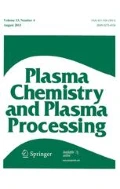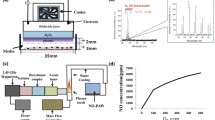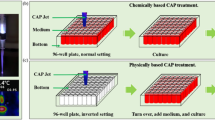Abstract
In the last decades, there have been numerous reports about the separate interactions of a magnetic field and cold atmospheric plasma (CAP) with the biological systems. We have investigated the combined effect of CAP with the static magnetic field (SMF) as an effective method for cancer cells treatment. MDA-MB-231 breast cancer cells were cultured and treated with CAP with different input power and exposure times in the presence and absence of the SMF. Vitamin C was also used in medium, and cell viability was investigated in the presence and absence of this antioxidant compound. The MTT assay was employed to measure cell survival, and a T-test or one-way ANOVA was used to assess the significance level of quantitative data. In order to determine the migration rate of cancer cells, wound healing assay was carried out. Results show that the presence of the SMF and vitamin C as well as increasing the input power significantly decrease the survival and migration rate of the cells. The results of the present investigation will greatly contribute to improve the CAP efficiency in cancer therapy by using the SMF and vitamin C as a complement to conventional CAP therapies.












Similar content being viewed by others
References
Weltmann KD, Kindel E, von Woedtke T et al (2010) Atmospheric-pressure plasma sources: prospective tools for plasma medicine. Pure Appl Chem 82:1223–1237
Yousfi M, Merbahi N, Pathak A, Eichwald O (2014) Low-temperature plasmas at atmospheric pressure: toward new pharmaceutical treatments in medicine. Fundam Clin Pharmacol 28:123–135
Graves DB (2012) The emerging role of reactive oxygen and nitrogen species in redox biology and some implications for plasma applications to medicine and biology. J Phys D Appl Phys 45:263001
Zhang Z, Xu Z, Cheng C et al (2017) Bactericidal effects of plasma induced reactive species in dielectric barrier gas-liquid discharge. Plasma Chem Plasma Process 37:415–431. https://doi.org/10.1007/s11090-017-9784-z
Xin Q, Zhang X, Lei L (2008) Inactivation of bacteria in oil field injection water by non-thermal plasma treatment. Plasma Chem Plasma Process 28:689–700. https://doi.org/10.1007/s11090-008-9152-0
Daeschlein G, von Woedtke T, Kindel E et al (2010) Antibacterial activity of an atmospheric pressure plasma jet against relevant wound pathogens in vitro on a simulated wound environment. Plasma Process Polym 7:224–230. https://doi.org/10.1002/ppap.200900059
Shapourzadeh A, Rahimi-Verki N, Atyabi SM et al (2016) Inhibitory effects of cold atmospheric plasma on the growth, ergosterol biosynthesis, and keratinase activity in Trichophyton rubrum. Arch Biochem Biophys 608:27–33. https://doi.org/10.1016/j.abb.2016.07.012
Rupf S, Lehmann A, Hannig M et al (2010) Killing of adherent oral microbes by a non-thermal atmospheric plasma jet. J Med Microbiol 59:206–212
Stoffels E, Sakiyama Y, Graves DB (2008) Cold atmospheric plasma: charged species and their interactions with cells and tissues. IEEE Trans Plasma Sci 36:1441–1457
Heinlin J, Morfill G, Landthaler M et al (2010) Plasma medicine: possible applications in dermatology. JDDG J der Dtsch Dermatologischen Gesellschaft 8:968–976
Ehlbeck J, Schnabel U, Polak M et al (2010) Low temperature atmospheric pressure plasma sources for microbial decontamination. J Phys D Appl Phys 44:13002. https://doi.org/10.1088/0022-3727/44/1/013002
Keidar M (2015) Plasma for cancer treatment. Plasma Sources Sci Technol 24:33001
Bekeschus S, Kolata J, Winterbourn C et al (2014) Hydrogen peroxide: a central player in physical plasma-induced oxidative stress in human blood cells. Free Radic Res 48:542–549
Liu Z, Xu D, Zhou C et al (2018) Effects of the pulse polarity on helium plasma jets: discharge characteristics, key reactive species, and inactivation of myeloma cell. Plasma Chem Plasma Process. https://doi.org/10.1007/s11090-018-9920-4
Lu X, Naidis GV, Laroussi M et al (2016) Reactive species in non-equilibrium atmospheric-pressure plasmas: generation, transport, and biological effects. Phys Rep 630:1–84. https://doi.org/10.1016/J.PHYSREP.2016.03.003
Winterbourn CC (2008) Reconciling the chemistry and biology of reactive oxygen species. Nat Chem Biol 4:278
Ghodbane S, Lahbib A, Sakly M, Abdelmelek H (2013) Bioeffects of static magnetic fields: oxidative stress, genotoxic effects, and cancer studies. Biomed Res Int 2013:602987. https://doi.org/10.1155/2013/602987
Hashish AH, El-Missiry MA, Abdelkader HI, Abou-Saleh RH (2008) Assessment of biological changes of continuous whole body exposure to static magnetic field and extremely low frequency electromagnetic fields in mice. Ecotoxicol Environ Saf 71:895–902
Jing D, Shen G, Cai J et al (2010) Effects of 180 mT static magnetic fields on diabetic wound healing in rats. Bioelectromagnetics 31:640–648
Brkovic S, Postic S, Ilic D (2015) Influence of the magnetic field on microorganisms in the oral cavity. J Appl Oral Sci 23:179–186
Sadri M, Abdolmaleki P, Abrun S et al (2017) Static magnetic field effect on cell alignment, growth, and differentiation in human cord-derived mesenchymal stem cells. Cell Mol Bioeng 10:249–262. https://doi.org/10.1007/s12195-017-0482-y
Li J, Ma Y, Li N et al (2014) Natural static magnetic field-induced apoptosis in liver cancer cell. Electromagn Biol Med 33:47–50
Dobson J (2012) Cancer therapy: death by magnetism. Nat Mater 11:1006
Markov MS (2007) Therapeutic application of static magnetic fields. Environmentalist 27:457–463
Sureda A, Batle JM, Tauler P et al (2006) Vitamin C supplementation influences the antioxidant response and nitric oxide handling of erythrocytes and lymphocytes to diving apnea. Eur J Clin Nutr 60:838–846. https://doi.org/10.1038/sj.ejcn.1602388
Ohno S, Ohno Y, Suzuki N et al (2009) High-dose vitamin C (ascorbic acid) therapy in the treatment of patients with advanced cancer. Anticancer Res 29:809–815
Amatore C, Arbault S, Ferreira DCM et al (2008) Vitamin C stimulates or attenuates reactive oxygen and nitrogen species (ROS, RNS) production depending on cell state: quantitative amperometric measurements of oxidative bursts at PLB-985 and RAW 264.7 cells at the single cell level. J Electroanal Chem 615:34–44. https://doi.org/10.1016/j.jelechem.2007.11.037
Ha YM, Park MK, Kim HJ et al (2009) High concentrations of ascorbic acid induces apoptosis of human gastric cancer cell by p38-MAP kinase-dependent up-regulation of transferrin receptor. Cancer Lett 277:48–54
Cheng X, Rajjoub K, Shashurin A et al (2017) Enhancing cold atmospheric plasma treatment of cancer cells by static magnetic field. Bioelectromagnetics 38:53–62. https://doi.org/10.1002/bem.22014
Deng G, Jin Q, Yin S et al (2018) Experimental study on bacteria disinfection using a pulsed cold plasma jet with helium/oxygen mixed gas. Plasma Sci Technol. https://doi.org/10.1088/2058-6272/aacaee
Duan Y, Huang C, Yu QS (2007) Cold plasma brush generated at atmospheric pressure. Rev Sci Instrum. https://doi.org/10.1063/1.2409624
Dringen R, Kussmaul L, Hamprecht B (1998) Detoxification of exogenous hydrogen peroxide and organic hydroperoxides by cultured astroglial cells assessed by microtiter plate assay. Brain Res Protoc 2:223–228. https://doi.org/10.1016/S1385-299X(97)00047-0
Hojnik N, Modic M, Ni Y et al (2019) Effective fungal spore inactivation with an environmentally friendly approach based on atmospheric pressure air plasma. Environ Sci Technol 53:1893–1904. https://doi.org/10.1021/acs.est.8b05386
Liu ZC, Liu DX, Chen C et al (2015) Physicochemical processes in the indirect interaction between surface air plasma and deionized water. J Phys D Appl Phys 48:495201
Machala Z, Tarabova B, Hensel K et al (2013) Formation of ROS and RNS in water electro-sprayed through transient spark discharge in air and their bactericidal effects. Plasma Process Polym 10:649–659
Tian W, Kushner MJ (2014) Atmospheric pressure dielectric barrier discharges interacting with liquid covered tissue. J Phys D Appl Phys 47:165201
Safari R, Sohbatzadeh F (2015) Effect of DC magnetic field on atmospheric pressure argon plasma jet. Indian J Phys 89:495–502. https://doi.org/10.1007/s12648-014-0609-0
Ledda M, Megiorni F, Pozzi D et al (2013) Non ionising radiation as a non chemical strategy in regenerative medicine: Ca2+-ICR “in vitro” effect on neuronal differentiation and tumorigenicity modulation in NT2 cells. PLoS ONE 8:e61535. https://doi.org/10.1371/journal.pone.0061535
Raylman RR, Clavo AC, Wahl RL (1996) Exposure to strong static magnetic field slows the growth of human cancer cells in vitro. Bioelectromagn J Bioelectromagn Soc 17:358–363
Gurhan H, Bruzón R, Xiong Y, Barnes F (2018) Effect of a low intensity static magnetic field on different biological parameters that characterize the cellular stress. In: 2018 United States National Committee of URSI National Radio Science Meeting (USNC-URSI NRSM), pp 1–2
Friedl P, Gilmour D (2009) Collective cell migration in morphogenesis, regeneration and cancer. Nat Rev Mol Cell Biol 10:445
Schmidt A, Bekeschus S, von Woedtke T, Hasse S (2015) Cell migration and adhesion of a human melanoma cell line is decreased by cold plasma treatment. Clin Plasma Med 3:24–31. https://doi.org/10.1016/j.cpme.2015.05.003
Yun J, Mullarky E, Lu C et al (2015) Vitamin C selectively kills KRAS and. Science (80-) 350:1391–1396
Lv H, Wang C, Fang T et al (2018) Vitamin C preferentially kills cancer stem cells in hepatocellular carcinoma via SVCT-2. Precis Oncol 2:1. https://doi.org/10.1038/s41698-017-0044-8
Padayatty SJ, Riordan HD, Hewitt SM et al (2006) Intravenously administered vitamin C as cancer therapy: three cases. CMAJ 174:937–942. https://doi.org/10.1503/cmaj.050346
Lim JY, Kim D, Kim BR et al (2016) Vitamin C induces apoptosis in AGS cells via production of ROS of mitochondria. Oncol Lett 12:4270–4276. https://doi.org/10.3892/ol.2016.5212
Maramag C, Menon M, Balaji KC et al (1997) Effect of vitamin C on prostate cancer cells in vitro: effect on cell number, viability, and DNA synthesis. Prostate 32:188–195. https://doi.org/10.1002/(SICI)1097-0045(19970801)32
Ma Y, Ha CS, Hwang SW et al (2014) Non-thermal atmospheric pressure plasma preferentially induces apoptosis in p53-mutated cancer cells by activating ROS stress-response pathways. PLoS ONE 9:e91947
Ishaq M, Kumar S, Varinli H et al (2014) Atmospheric gas plasma-induced ROS production activates TNF-ASK1 pathway for the induction of melanoma cancer cell apoptosis. Mol Biol Cell 25:1523–1531
Author information
Authors and Affiliations
Corresponding author
Additional information
Publisher's Note
Springer Nature remains neutral with regard to jurisdictional claims in published maps and institutional affiliations.
Rights and permissions
About this article
Cite this article
Mehrabifard, R., Mehdian, H., Hajisharifi, K. et al. Improving Cold Atmospheric Pressure Plasma Efficacy on Breast Cancer Cells Control-Ability and Mortality Using Vitamin C and Static Magnetic Field. Plasma Chem Plasma Process 40, 511–526 (2020). https://doi.org/10.1007/s11090-019-10050-5
Received:
Accepted:
Published:
Issue Date:
DOI: https://doi.org/10.1007/s11090-019-10050-5




